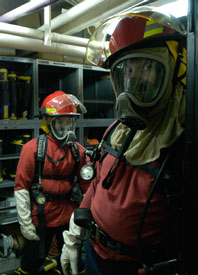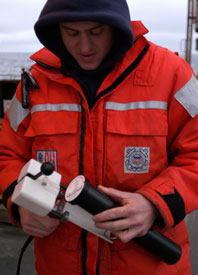 |
Daily Update
Calendar
Dispatch 36 - October 15, 2003
By C. A. Linder
Weather conditions: Overcast skies, 20 kt winds, 2-3 ft seas,
air temperature 30°F
Countdown
The big countdown has started... The last CTD section has been posted
on the white board, and the end is in sight. In only a few days
we'll be back on land, heading home. The crew of the Healy
is even more excited - this science expedition is the last one of
the summer season. Their long deployment, which started in June,
will be over shortly after they drop
us off in Nome.
Our eddy hunt today was a success. We found what we were looking
for - evidence in both the temperature and turbidity (water "dirtiness")
data that an eddy was present on the shelf edge. The eddy was located
at 300 feet in depth. Since the eddy was carrying shelf waters off
into the deep basin, it had picked up (entrained) dirt and phytoplankton
and carried them over the shelf edge. Dean
Stockwell noticed it right away when he compared
two water samples. The deeper sample contained a lot more mud
and biological matter than a sample taken only 100 feet above.
 |  |
| This is only a drill... Fireman Brock (foreground) and Seaman Swibold (background) are dressed for firefighting. |
Click
to enlarge
|
 |  |
| Boatswain's mate Scott Lussier loads an expendable bathythermograph (XBT). |
| Click
to enlarge |
These questions about arctic plankton come from
Mrs. Lyons' 5th grade class at Mt. Alvernia Academy in Chestnut
Hill, Massachusetts. Dean Stockwell is a researcher at the
University of Alaska, Fairbanks. He has been studying polar phytoplankton
for over 25 years, with countless trips to both Arctic and Antarctic
waters.
Question from Gina and James: Can plants photosynthesize underwater, and how do they survive during the winter when there is no sun and it is very cold?
Answer from Dean: "Yes, photosynthesis can
take place underwater. The seaweeds we are all familiar with along
our coastlines are photosynthetic plants.
Polar regions present marine plants with a difficult problem, how
to survive the long periods of winter darkness. Many of the microscopic
algae that occupy polar oceans have the ability to produce resting
stages. During this time all plant processes are reduced to a minimum.
Perhaps you can compare it to a bear's hibernation. Other plants actually
produce specialized resting spores which protect the cell until light
conditions improve."
Question from Ryan and Patricia:What is your hypothesis so far concerning the temperature of the water? Do you think it is changing and will this kill the algae?
Answer: These are both good questions. Water temperatures
change over many different time scales. They range from very short
time scales, such as those we have recently observed with the eddies,
to very long time scales, such as the freezing and thawing of ice
ages. The data the moorings have collected will be very important
in determining how the water changes over the course of a year. Since
the moorings are going to be deployed for two years, we can then compare
how the temperature behaves from one year to the next. Those are called
interannual changes. To fully understand how the temperature changes
you would need the longest possible data record - several hundred
years would be a good start! That's why there's still so many unsolved
problems in oceanography. If one of you becomes an arctic oceanographer
some day, you could be comparing our temperature measurements to those
that you have collected!
Dean had this to say about the algae: "If in
fact temperatures begin to rise in polar oceans, many of the algae
forms present may die out. Extinctions are common in the geologic
record. This warmimg, however, may also allow species now living in
warmer waters to extend their habitat ranges into these newly warmed
waters. As cold water species leave town, warm water species move
in."
For Brian and his classmates at Wayzata
West Middle School who have been wondering about the worm
that we brought up on one of the moorings, I have an update. Carin
Ashjian brought the preserved worm back to Woods Hole Oceanographic
Institution and showed it to some colleagues in the biology department.
They thought it was interesting enough to put the tiny creature
through a very specialized CAT scanner! Hopefully we'll know more
in the next few days - I'll keep you posted.
 Previous
Dispatch
Next Dispatch Previous
Dispatch
Next Dispatch

Back to
Calendar
|




